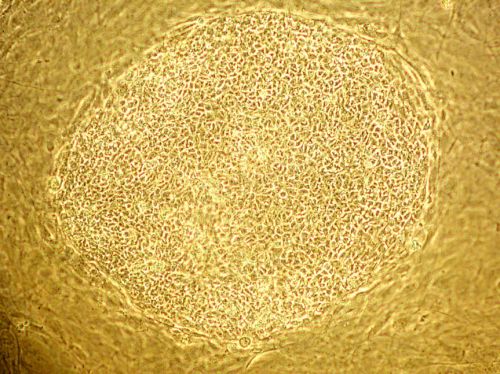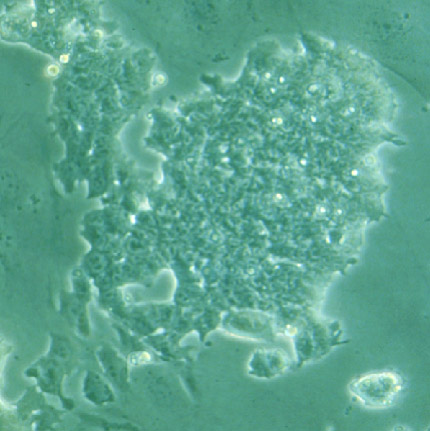The meaning of life
 Yesterday media outlets announced the news of a breakthrough in stem-cell research. The details were published in the prestigious journals Science and Cell (PDF). Translating the research for readers of mainstream media has challenged reporters all over the globe. Two different teams of scientists have figured out a means to obtain pluripotent stem cells without creating -- or destroying -- an embryo. In fact, no human reproductive material was used at all, including eggs. Now, most pluripotent stem cells are known as embryonic stem cells, meaning they come from an embryo. The new technology, called Direct Cell Reprogramming or Induced Pluripotent State, takes adult cells and regenerates them back to the pluripotent state. It's quite similar to embryonic stem cells, but they are not embryonic stem cells.
Yesterday media outlets announced the news of a breakthrough in stem-cell research. The details were published in the prestigious journals Science and Cell (PDF). Translating the research for readers of mainstream media has challenged reporters all over the globe. Two different teams of scientists have figured out a means to obtain pluripotent stem cells without creating -- or destroying -- an embryo. In fact, no human reproductive material was used at all, including eggs. Now, most pluripotent stem cells are known as embryonic stem cells, meaning they come from an embryo. The new technology, called Direct Cell Reprogramming or Induced Pluripotent State, takes adult cells and regenerates them back to the pluripotent state. It's quite similar to embryonic stem cells, but they are not embryonic stem cells.
So that's my first note -- headlines such as these two from National Public Radio are problematic:
Skin Cells Can Become Embryonic Stem Cells
Scientists Create Embryonic Stem Cells from Skin
On the other hand, many reporters did a great job of explaining and translating the science and its ethical impact. Here, for example, is Gina Kolata in The New York Times:
Two teams of scientists reported yesterday that they had turned human skin cells into what appear to be embryonic stem cells without having to make or destroy an embryo -- a feat that could quell the ethical debate troubling the field.
All they had to do, the scientists said, was add four genes. The genes reprogrammed the chromosomes of the skin cells, making the cells into blank slates that should be able to turn into any of the 220 cell types of the human body, be it heart, brain, blood or bone. Until now, the only way to get such human universal cells was to pluck them from a human embryo several days after fertilization, destroying the embryo in the process.
The need to destroy embryos has made stem cell research one of the most divisive issues in American politics, pitting President Bush against prominent Republicans like Nancy Reagan, and patient advocates who hoped that stem cells could cure diseases like Alzheimer's. The new studies could defuse the issue as a presidential election nears.
The reprogrammed skin cells may yet prove to have subtle differences from embryonic stem cells that come directly from human embryos, and the new method includes potentially risky steps, like introducing a cancer gene. But stem cell researchers say they are confident that it will not take long to perfect the method and that today's drawbacks will prove to be temporary.
Researchers and ethicists not involved in the findings say the work, conducted by independent teams from Japan and Wisconsin, should reshape the stem cell field. At some time in the near future, they said, today's debate over whether it is morally acceptable to create and destroy human embryos to obtain stem cells should be moot.
"Everyone was waiting for this day to come," said the Rev. Tadeusz Pacholczyk, director of education at the National Catholic Bioethics Center. "You should have a solution here that will address the moral objections that have been percolating for years," he added.
Good thing Missouri enshrined embryonic destruction into its constitution! Thinking back to that election battle, one of the criticisms I had was that the mainstream media kept referring to supporters of the Missouri amendment as "favoring stem-cell research." Of course, everyone, more or less, favors stem-cell research. Stem cells have been considered very exciting avenues for research because of their remarkable potential to develop into different cell types in the body (muscle cell, brain cell, skin cell). Some stem cells come from adults while other stem cells come from embryos. Each type has various advantages and disadvantages. Some people don't think advances in science should come by destroying embryos. Others think that destroying embryos is a price you have to pay for the possibility of developing cures to diseases.
 What's neat about the recent news is the potential improvements on the most promising line of research -- without destroying embryos or requiring women to donate or sell their eggs.
What's neat about the recent news is the potential improvements on the most promising line of research -- without destroying embryos or requiring women to donate or sell their eggs.
Well, all of a sudden, the media seem to have figured out this distinction between stem-cell research and embryonic stem-cell research. Obviously the whole hook of the story was that pluripotent stem cells are being obtained without killing embryos. So reporters had to explain the distinction between embryo-destroying research and non-embryo-destroying research. But what a shame that they hadn't been doing a better job of this earlier.
Anyway, there are many stories out there about this recent advance. In addition to a straight news story, The Washington Post explored the political significance of the finding:
Still, even skeptics of the president's approach acknowledged that the new findings could make it more difficult to keep up the political momentum for embryo research, even if scientists say it is too early to abandon it. Most immediately, some said, it could hurt the effort to override Bush's June veto of a bill that would have loosened the rules on federal funding.
The Los Angeles Times had a thorough article with an interesting comment thread. Kolata had a follow-up story for the Times about one of the scientists who broke the latest discovery, James Thomson. He was the same scientist who touched off debate on embryonic stem-cell research in 1998 when he took stem cells from embryos:
The fact is, Dr. Thomson said in an interview, he had ethical concerns about embryonic research from the outset, even though he knew that such research offered insights into human development and the potential for powerful new treatments for disease.
"If human embryonic stem cell research does not make you at least a little bit uncomfortable, you have not thought about it enough," he said. "I thought long and hard about whether I would do it."
Interesting. USA TODAY reported on the ethical concerns remaining, something religion reporter Gary Stern highlighted on his blog. Finally, if you are looking for an excellent analysis of the medical and political significance, I recommend (my fellow Phillips Fellow) Ryan Anderson's piece in The Weekly Standard.